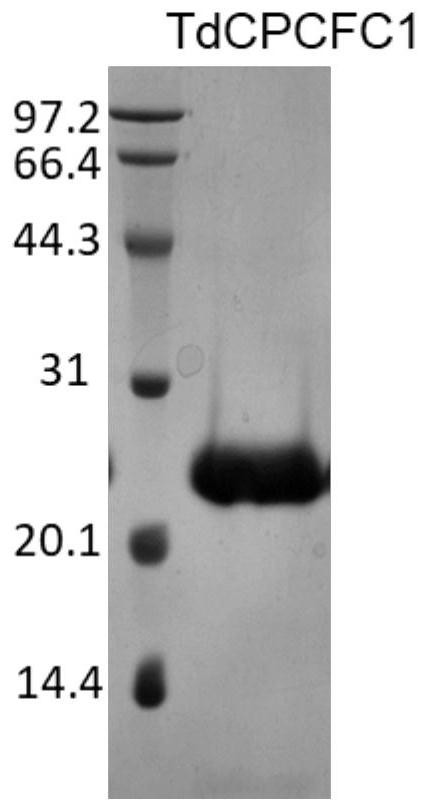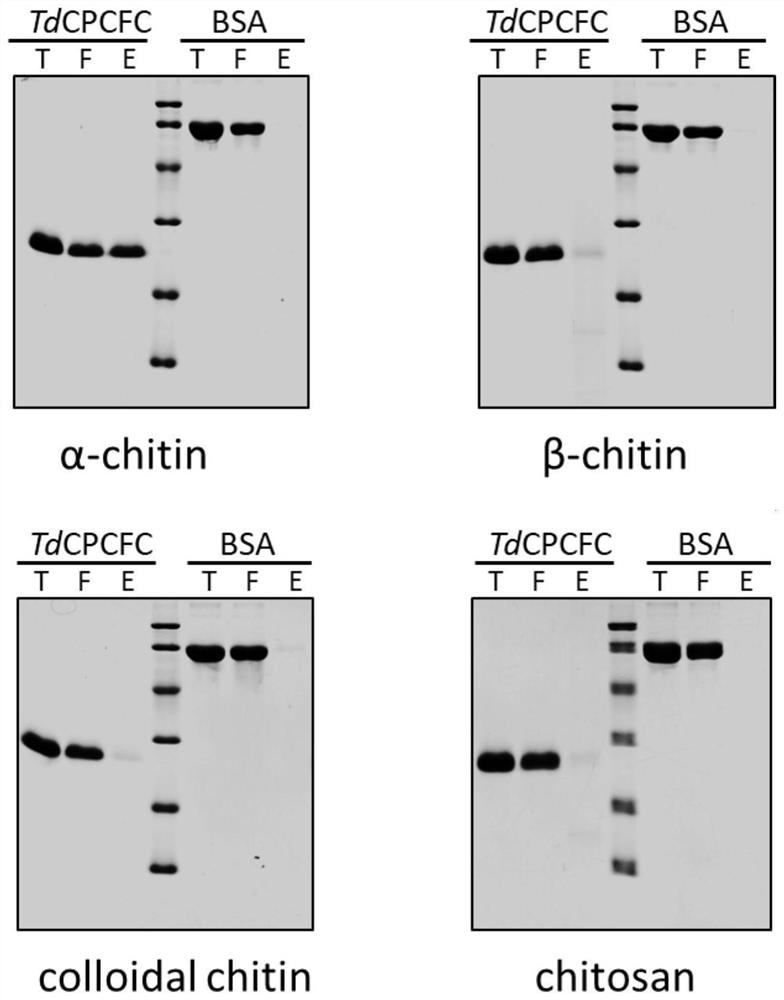Insect cpcfc family epidermal protein, coding nucleotide sequence and application thereof
A nucleotide sequence and epidermal protein technology, applied in the field of bioengineering, can solve problems such as unreported research
- Summary
- Abstract
- Description
- Claims
- Application Information
AI Technical Summary
Problems solved by technology
Method used
Image
Examples
Embodiment 1
[0085] Example 1 Cloning and expression purification of Tdcpcfc1 gene
[0086] 1. Synthetic SEQ ID Nucleotide sequence shown in NO.5
[0087] (1) Extract total RNA from the horns of the pupal stage of the two-fork rhinoceros beetle, and use reverse transcriptase to synthesize the first strand of cDNA;
[0088] (2) using cDNA as a template, using upstream primer 1 and downstream primer 2 to perform PCR (polymerase chain reaction) amplification;
[0089] Upstream primer 1: 5'-ATGTTTGTAAAACTGGCAGTATTAGCTTG-3' (SEQ ID NO.7),
[0090] Downstream primer 2: 5'-TTAATGGCAGAATGGGTAATTTGGACA-3' (SEQ ID NO.8).
[0091] PCR reaction system: 1μL cDNA template, 25uL 2×exTaq Premix, 1.5uL upstream primer 1, 1.5uL downstream primer 2, supplemented with ddH 2 O (double distilled water) to total reaction system is 50uL;
[0092] The PCR reaction conditions are ①98°C, 10s; ②55°C, 30s; ③72°C, 1min; ④Repeat steps ①-③30 cycles;
[0093] (3) After the PCR product is purified and recovered,...
Embodiment 2
[0109] Example 2 Detection of TdCPCFC1 protein binding properties of metal ions
[0110] Binding of Cu element during the culture of recombinant Escherichia coli
[0111]The recombinant Escherichia coli obtained in Example 1 was harvested after being induced by LB medium. During the process of expressing protein after adding the inducer, Escherichia coli would automatically absorb the Cu element in the medium, and the bacteria appeared brick red. The isolated 1.9mL, 2.63mg / mL pure protein was subjected to ICP-AES (Inductively Coupled Plasma Emission Spectroscopy), and it was measured that TdCPCFC1 protein bound 0.023mg Cu element, and the molar ratio of protein to Cu was about 1:1.
Embodiment 3
[0112] Example 3 Detection of TdCPCFC1 Protein Reduction
[0113] 1. Quantity determination of TdCPCFC1 protein Cys
[0114] Theoretically, one TdCPCFC1 protein contains 4 Cys (excluding the signal peptide region). The standard curve was prepared with Cys standards, and the UV absorption at 412nm was detected by Ellman's Reagent reaction. It was measured that the completely reduced state was 4 Cys, but it was not treated. The protein contains 2 Cys. The results showed that in the purified protein TdCPCFC1, 2 of the 4 Cys formed disulfide bonds, and the other two were free. The protein was reductive.
[0115] 2. TdCPCFC1 protein reduces Cu(II)
[0116] Use Bcs to detect the production of Cu(I), Bcs can specifically bind Cu(I), and there is ultraviolet absorption at 483nm, respectively use purified protein and EDTA+TCEP (chelating agent+reducing agent treatment to make protein without Cu element, And after reducing agent treatment, reduce all Cys as a control) Treated pur...
PUM
 Login to View More
Login to View More Abstract
Description
Claims
Application Information
 Login to View More
Login to View More - R&D
- Intellectual Property
- Life Sciences
- Materials
- Tech Scout
- Unparalleled Data Quality
- Higher Quality Content
- 60% Fewer Hallucinations
Browse by: Latest US Patents, China's latest patents, Technical Efficacy Thesaurus, Application Domain, Technology Topic, Popular Technical Reports.
© 2025 PatSnap. All rights reserved.Legal|Privacy policy|Modern Slavery Act Transparency Statement|Sitemap|About US| Contact US: help@patsnap.com



